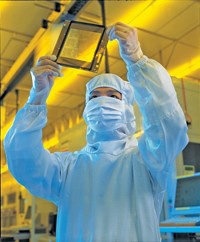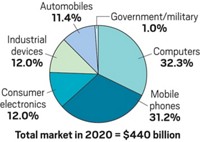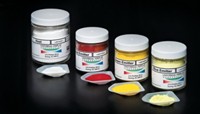Advertisement
Grab your lab coat. Let's get started
Welcome!
Welcome!
Create an account below to get 6 C&EN articles per month, receive newsletters and more - all free.
It seems this is your first time logging in online. Please enter the following information to continue.
As an ACS member you automatically get access to this site. All we need is few more details to create your reading experience.
Not you? Sign in with a different account.
Not you? Sign in with a different account.
ERROR 1
ERROR 1
ERROR 2
ERROR 2
ERROR 2
ERROR 2
ERROR 2
Password and Confirm password must match.
If you have an ACS member number, please enter it here so we can link this account to your membership. (optional)
ERROR 2
ACS values your privacy. By submitting your information, you are gaining access to C&EN and subscribing to our weekly newsletter. We use the information you provide to make your reading experience better, and we will never sell your data to third party members.
Business
Bright Outlook For LED Precursor
Large new applications are behind boom in the trimethylgallium business
by Alexander H Tullo
July 11, 2011
| A version of this story appeared in
Volume 89, Issue 28

The changes may be hard to notice, but light-emitting diodes are creeping into our daily lives. Thanks in part to LEDs, laptop batteries last longer between charges than they did a few years ago. LEDs permit the newest television models to be thinner and brighter than older ones. And white LED bulbs are starting to appear in the lighting departments of retailers such as the Home Depot.
COVER STORY
Bright Outlook For LED Precursor
For producers of a critical LED rawmaterial, trimethylgallium (TMG), the changes haven’t been so subtle. To staveoff shortages, they are planning to add capacity well before they’ve completed earlier projects. Major producers including AkzoNobel, Dow Chemical, and Sigma-Aldrich’s SAFC Hitech unit all have undertaken multiple expansions over the past year. Chemtura is entering the market through a Korean joint venture.
TMG is a precursor used in chemical vapor deposition chambers to lay down layers of elemental gallium for compound semiconductors like gallium nitride and indium gallium nitride. These semiconductors are used in blue LEDs, which are coated with phosphors to make them emit white light. TMG is also a precursor for gallium arsenide (GaAs) semiconductors that end up in lasers, photovoltaic cells, and telecommunication devices.
LEDs have spurred the precursor’s enormous growth over the past few years—25 to 30% annually by most accounts. Asif Anwar, director of the GaAs and compound semiconductor service at the consulting group Strategy Analytics, forecasts that the LED market will grow at an annual clip of 22% through 2014, at which time it will reach $19 billion. Raw materials such as TMG and the sapphire wafer substrates to which the precursors are applied will grow at a similar rate, he says.
LED growth has occurred in several phases, Anwar explains, beginning with the use of LED backlights to illuminate cell phones, laptops, and other small devices. Today, nearly all of these gadgets use LED backlights instead of compact fluorescent lights (CFLs).
The second cycle, Anwar says, began about 18 months ago with the introduction of LED-backlit flat-panel TVs. LEDs offer a number of advantages over the CFLs that TV makers used for many years: They consume less power and last longer than CFL bulbs, and their compactness makes thinner TVs possible. Moreover, LEDs can be controlled better than CFLs, allowing light to be directed where it is needed on the screen. This makes for more vivid colors and better contrast ratios.
The wave of TV growth has challenged the TMG industry to keep up. “Companies like Samsung brought out their LED televisions with a very rapid manufacturing ramp-up,” says Geoff Irvine, vice president of business development at SAFC Hitech. “The market took off in terms of demand, and there was a shortage of TMG and sapphire substrates.”
Although they sometimes seem ubiquitous, LEDs command only 30 to 40% of the world TV market, according to Michiel Floor, global business manager for high-purity metal organics at AkzoNobel. “So there is a way to go in terms of growth potential in the TV market,” he says.
The third cycle of LED growth will be the adoption of LED lighting for residential use, Anwar says. This market is largely the result of legislation. A U.S. phaseout of conventional incandescent lightbulbs will begin next January with the ban of the 100- W bulb. Many countries around the world have similar plans.
LEDs will vie with CFLs for the enormous lighting market that is up for grabs. LEDs are somewhat more energy efficient than CFLs, and they last about 50,000 hours, versus 10,000 hours for CFLs. But LEDs are expensive. A recent C&EN check of the Home Depot found 40-W-equivalent LED bulbs on sale for about $18 each. Comparable fluorescents were on sale for about $1.00 each. To capture more of the lighting market, Anwar says, LED makers must bring costs down to a “more manageable level” by scaling up manufacturing.
Luckily, the industry is already doing so because of TV demand. LED makers have been borrowing methods from computer semiconductor makers, observes Joe Reiser, global business director for metal-organic technologies at Dow Chemical. “As the industry matures, we see more of a larger scale manufacturing mentality akin to what we see in the semiconductor world,” he says. “The parallels are pretty striking.”
For example, LED makers have been processing bigger and bigger wafers, much as semiconductor chip makers have done. By increasing wafer size, they can cram more usable LED chips onto each wafer. Already, the LED industry has moved from 2-inch wafers to 4-inch wafers, Anwar says, and is transitioning to 6-inch wafers, which he expects will be mainstream by 2014.
TMG producers are doing their part to scale up with LED makers. AkzoNobel’s recent experience illustrates how challenging it has been to keep pace.
AkzoNobel doubled TMG capacity at its La Porte, Texas, plant in June 2010. It did so again this past January. “We are sold out again, which is amazing,” Floor says, noting the company is now adding incremental capacity at the site.
The company is also planning an entirely new TMG plant in La Porte. It will be three times the size of its recently expanded plant, giving Akzo more than 100 metric tons of total gallium-based metal-organic capacity per year and making the company, Floor claims, the TMG market leader.
Although most LEDs are made in Asia, Floor says Akzo chose to build the new plant in La Porte because “it was the fastest way for us to make this happen.” Akzo already has infrastructure in place for handling TMG, a hazardous pyrophoric chemical.
In addition, Akzo, along with Chemtura and Albemarle, is a major supplier of trimethylaluminum (TMA), used to synthesize both TMG and methylaluminoxane, a cocatalyst for metallocene polyolefin catalysts. Akzo makes TMA in La Porte.
That back-integration is an important advantage, Floor says, especially now, because TMA also is in short supply. Akzo’s heritage, he notes, is “completely different” from any of its competitors’.
The heritage, however, will soon be less atypical. Earlier this year Chemtura and South Korea’s UP Chemical formed a joint venture, DayStar Materials, that intends to have TMG and TMA capacity in Korea running by the end of this year. Chemtura has also been explanding capacity for TMA and another organometallic precursor, diethylzinc, at its plant in Bergkamen, Germany.
The industry’s other TMG suppliers are electronic chemicals firms that offer the precursor as part of a stable of products for the semiconductor industry. Dow got into the business through its 2009 acquisition of Rohm and Haas. SAFC did so through Sigma-Aldrich’s 2007 purchase of Epichem.
Both Dow and SAFC are also investing heavily in TMG. As shortages loomed last year, Dow announced a multipronged approach to expand capacity by 60 metric tons per year. The company boosted existing operations at its North Andover, Mass., plant and slated new capacity at the site. In addition, plans called for a new plant in Cheonan, South Korea.
Behind the scenes, however, Dow also built a new TMG plant at its massive flagship site in Freeport, Texas. “In Freeport, we have the infrastructure in place where we can add capacity in a much faster timeline than we would have traditionally,” Dow’s Reiser says, noting that the project was conceived in June 2010 and completed in November.
The infrastructure in Freeport was the key. The site handles a lot of TMA because of Dow’s extensive polyethylene operations there. The scale of the new plant is an order of magnitude larger than what Rohm and Haas would have been able to build on its own, he says.
Original plans called for the equipment in Freeport to be moved to South Korea. However, Dow ended up building an entirely new plant there and will leave the assets in Freeport in place to run as needed.
SAFC has also engaged in multiple expansions. Last year, the company invested $2 million to add capacity at its TMG facility in Bromborough, England. In addition, the company is building a new plant in Kaohsiung, Taiwan, that it expects to complete later this year.
Despite the flurry of expansions, suppliers aren’t concerned about TMG capacity getting too far ahead of demand. “The growth rate of LEDs has essentially doubled the size of the market every two-and-a-half years,” SAFC’s Irvine says. “With those kinds of growth rates, it will take only a little while to bring supply and demand back into balance.”





Join the conversation
Contact the reporter
Submit a Letter to the Editor for publication
Engage with us on Twitter